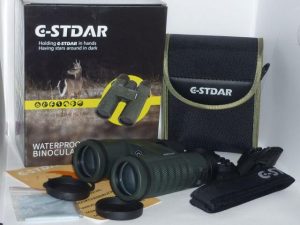This post contains affiliate links. If you click on a link and make a purchase I earn a small commission at no extra cost for you.
C-STDAR binoculars have been on the market for a little over 3 years now. It is an affordable binoculars brand from the Far East that consistently enjoys good reviews and satisfied customers. The C-STDAR 10×42 Waterproof binoculars are the only model under this label, it comes at a very competitive price. Let’s see if it meets the expectations of a nature lover and outdoor fan who only wants to spend little money on binoculars but who expects some decent optical performance for the money.
C-STDAR Binoculars
C-Stdar brand, never heard of them? It’s one of the many Chinese brands of binoculars. Oh, you may think. But let’s face it, what binoculars under $1000 aren’t made in the Far East? Yes, even the well-known traditional American brands that most people think are US-made, have almost everything made in Asia these days.
This is sure to be one reason why binoculars and optical products from this part of the world continue to improve and are quickly closing the gap in regard to the quality of optics and performance. After all, know-how was exported to meet American and European quality demands.
C-STDAR 10×42 Waterproof Binoculars Roof Prism
When the price is not an issue, getting good quality is always easy. But if you have a limited budget, you have to take a closer look. The C-STDAR 10 × 42 binoculars are currently available for under 100 dollars. I am sure that this is just an introductory price to push popularity and get the name out. Given the optical performance and the cost of comparable binoculars, it should come as no surprise when in a few months this model will cost at least twice as much.
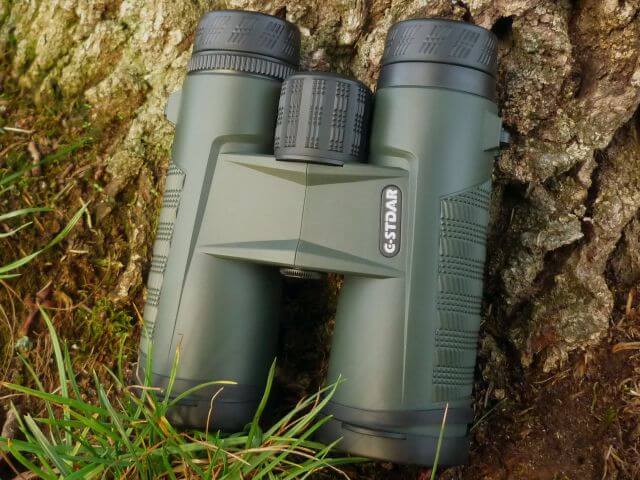
Specifications of C-STDAR 10×42 Waterproof Binoculars
| Optical Glass | HD Glass |
| Lens Coating | Fully Multi-coated |
| Prism type | BaK4 |
| Magnification | 10x |
| Objective diameter | 42 mm |
| Exit pupil | 4.2 mm |
| Eye relief | 15 mm |
| Field of view | 305ft/1000yrd 102m/1000m |
| Close focus | 10 feet 3 meter |
| Twilight factor | 20.49 |
| Water resistance | Waterproof/ Nitrogen filled |
| Weight | 21.2 oz/ 602 gr |
First Impression of the C-STDAR 10×42 Waterproof Binoculars
 The binos make a good impression when unpacking it from the box.
The binos make a good impression when unpacking it from the box.
Well packed in a sturdy bubble bag, something that you are only used to with higher-priced models.
Included are the 10×42 binoculars, lens cover, eyepiece covers, a padded carry case, strap for the case, neckstrap for the bino, cleaning cloth, and a manual with instructions and the specs listed.
Holding it, it lies comfortably in the hand, well-balanced with a pleasantly grippy rubber coating. The middle bridge hinge moves smoothly and evenly to adjust the distance between the eyes (IPD).
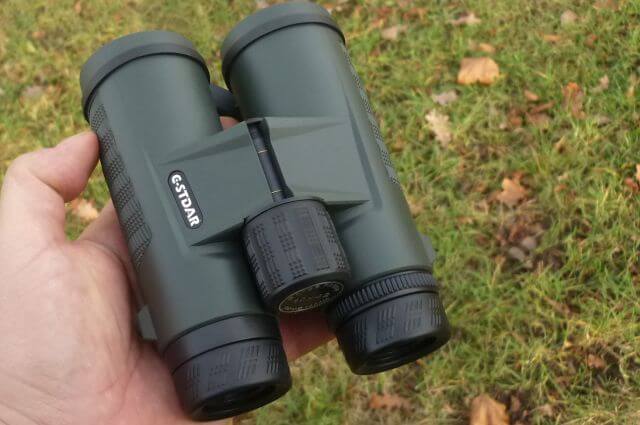
The Binoculars Housing
The chassis is made of polycarbonate, it is a strong and tough material, but at the same time, it is very lightweight. Most binoculars in the lower and middle price range are made of this material these days. The rubber armoring protects the instrument from bumps and shocks should it fall down, the eyepiece tubes are also rubber protected.
Dimensions and Weight
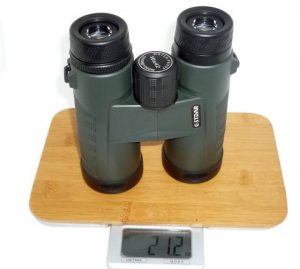
The C-star 10×42 just matches the average dimensions of other standard 10×42 roof prism binoculars. Also in terms of weight with under 22 ounces ( about 600 grams), the bino is not much different than most comparable instruments that are waterproof and nitrogen-filled.
Tripod Adapter Connection
22 ounces isn’t too heavy, but after hours of stationary observation, the instrument might seem to get heavier and heavier. Luckily you can screw on a tripod adapter so that you can mount it on a tripod.
Waterproof Fog Proof
The housing is O-ring sealed and nitrogen-filled which assures the binoculars are waterproof and fog-proof. Fog proof is always a great feature, as you don’t have any problems with inside lenses fogging up and lense fungus doesn’t have a chance either.
According to the manufacturer, the instrument even meets military standards MIL-STD-810, Water cannot get in when immersed, and it can cope with all other environmental harshnesses.
The exploded view lets you see the O-rings highlighted in light green. At the end of the objective tube is a permanently installed and O-ring sealed, planar-coated glass pane that seals the lens. The outer eyepiece lens is also sealed by an O-ring.
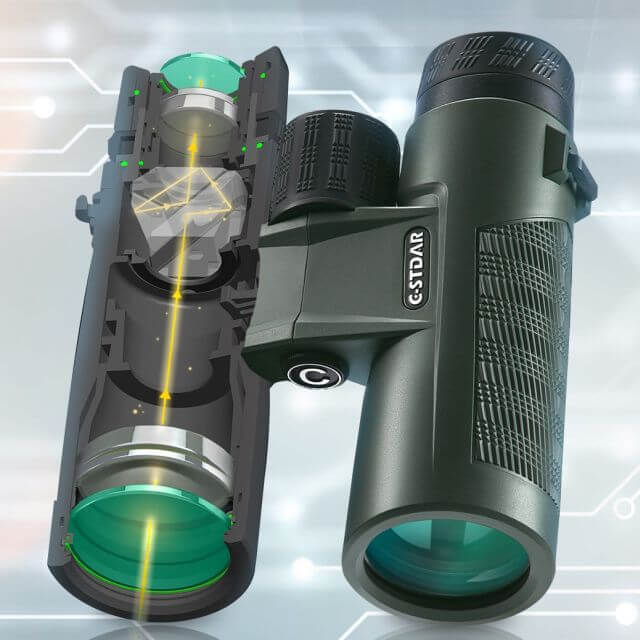
The Mechanics
Focus Wheel
One of the most important mechanical components of binoculars is the focusing wheel, it is in constant use. Focusing should be within 1.5 to 2 turns from very close to infinity, and nothing must wobble, jerk or run irregularly on it. Not only would that be annoying, but it would also severely limit the usability of the binoculars.
The focus wheel on the CStdar 10×42 is large, with a non-slip rubber surface, ergonomically placed, and easy to reach with the index and middle fingers. It turns smooth, evenly and without play, takes one and three-quarters to turn from near to far.
Middle Bridge & Hinge
Another moving part, which is just as crucial and must be precisely manufactured, is the central hinge. With it, you adjusted the barrels eyepieces to the distance between your eyes. The hinge of the C-Stdar 10×42′ middle bridge works fine and allows setting the interpupillary distance from 2.3 inches to 3 inches.
A good, accurate hinge that keeps the two binocular barrels exactly parallel to each other, as well as the precise arrangement of the lenses and prisms and the fine mechanical movement of the internal focusing, are essential for precisely aligned optical axes. This assures the two images merge into one, so you don’t see any double images.
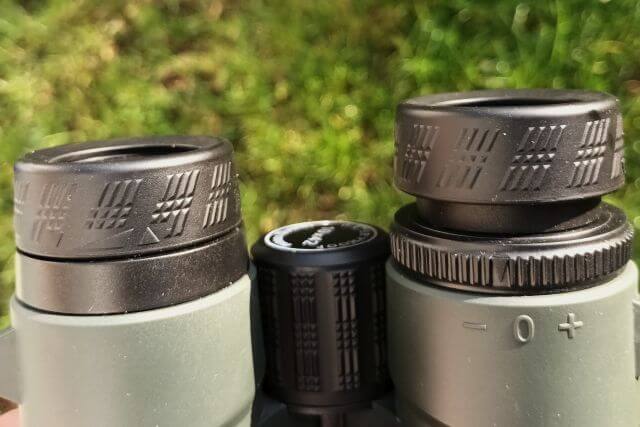
Diopter Compensation
Like most binoculars, the CStdar comes with a diopter compensation on the right eyepiece. There are no numbers, only +/- is given as a guideline. The datasheet does not contain any exact dioptric compensation figures either. My eyes differ by about 0.25 diopters and I have the diopter setting just off the 0, about a 1/10 of what’s possible.
The eyecups, which are ribbed for grip on the outside, can be twisted out by about a quarter of an inch with just the right force. In addition to the fully extended position, the twisting mechanism slightly engages in two other positions, if less distance is desired.
Optical Performance
10×42 binoculars, along with the 8×42, are clearly the most popular sizes, they are great all-around binoculars. Roof prism design in particular has marginalized Porros a bit in recent years.
10×42 provides very good detailed observation in daylight. 10 x 42 binoculars have more light-gathering power than needed in daylight, but a 42mm lens diameter allows for good viewing when it gets dark in shady woods or even at dusk, so they can even be used at night as long as there is a bit of light left.
The field of view of the CStdar 10×42 is 305 feet at 1000 yards. A higher magnification is at the expense of the field of view, it becomes narrower. Admittedly, there are models that have a much wider field of view with the same magnification, but they also cost a lot more.
Lens Coating
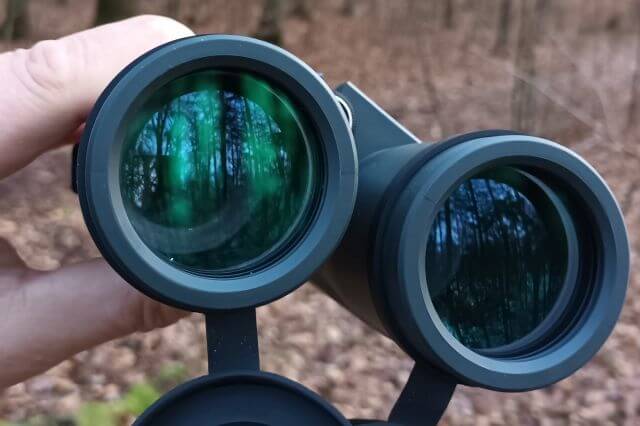
In addition to the twilight factor, which is calculated from the magnification and lens diameter, the coating of the lenses and prisms has a decisive influence on performance in low light. According to the description, the CStdar has lenses that are fully multi-coated. Fully multi-coated usually consists of several layers of vapor-deposited metal oxides, which increase the light transmission.
Prisms
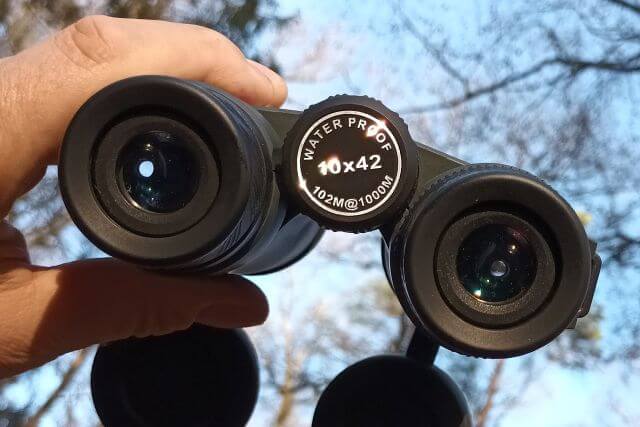
The binoculars are equipped with BaK-4 prisms. This is good because it enables better resolution and produces brighter, true-color, and high-contrast images.
The prism can be checked by holding the binoculars stretched out towards the light and looking at the eyepiece.
If the exit pupil is round and without shadows near the edge shading, this speaks for BaK4 glass from which the prisms are made. This has a better refractive index than the cheaper BK7 glass and has less light loss due to lower internal reflections.
Another contributing factor to the quality of roof design prisms is the type of coating. There are big differences as to whether the layers are vapor-deposited, dielectrically applied, and whether they are simply reflective or phase-correcting coatings. Unfortunately, the specs do not contain any information on the type of prism coating.
Eye Relief
15mm eye relief is quite good for such an affordable pair of binoculars. Users who have to wear glasses when looking through binoculars should be able to use the C-Stdar binoculars. 15mm eye relief is quite good for such an affordable pair of binoculars. In the case of complicated visual impairments, however, it might not do.
Close Focus
At close range, I was able to focus on objects from as low as about 11 feet away, nearer I could not focus. The close-up viewing from 11 feet + is fun, everything is sharp and rich in contrast.
Collimation
The collimation of the C-Stdar binoculars I bought was perfect.
In binoculars at the low end of the price bracket, the collimation is often not so perfect. Collimation means that the two optical axes run exactly parallel, otherwise, the images don’t merge into one, you see shifted images.
Edge sharpness and Edge Blurring
The C-STDAR 10 × 42 produces a bright, brilliant, and high-contrast image in the inner 50% of this field of view. The image sharpness decreases towards the edge, but that is to be expected in such affordable binoculars. If you want more image sharpness through the field of view and less edge blur, you have to dig much deeper into your pocket.
In practice, however, 50% is sufficient. If you see a bird or animal at the edge of the field of view, pan to the side and you can quickly focus on the object.

Color fidelity
When looking at nature, landscapes, and buildings, colors usually appear quite natural and normal, in the late afternoon, they appeared slightly warmer.
True colors and sharp images are essential for wildlife and bird watching. Lenses made of extra-low dispersion glass and phase-corrected prisms could improve that but would also double the price.
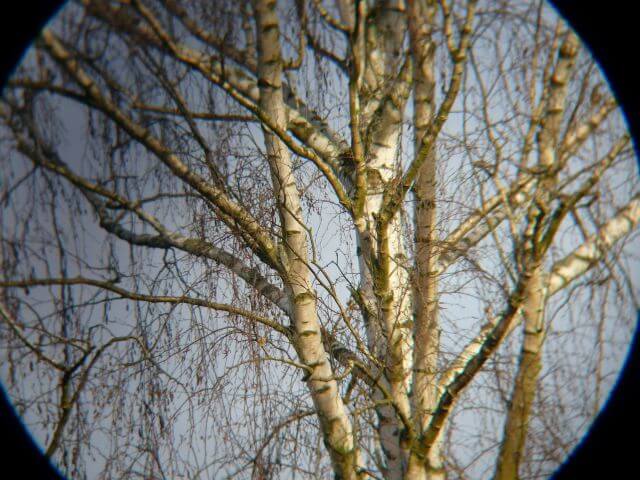
Chromatic Aberration / Color Fringing
Slight color fringing (chromatic aberrations) is visible on transition edges of light and dark contrasts through the entire image field. But they were faint enough not to be a problem.
Ghost images and light scattering
The bino performed really well when viewing in difficult light and against bright light. The baffles behind the objective lenses reduce stray light. Even when looking towards the low sun there was only a little white haze over parts of the image, light scattering is really quite well controlled

Advantages of C-STDAR 10×42 Waterproof Binoculars
- Great Build Quality
- Excellent Optical performance at this price
- Waterproof and Fog proof thanks to O-ring sealing
- Nitrogen purged
- Accessories: eyepiece and lens covers, cleaning cloth, padded carry case, neck-straps
Disadvantages 0f the C-STDAR 10×42 Waterproof Binoculars
So at the low price, I can’t really think of anything to complain about. Maybe:
- The product description talks about “Light Transmittance Up To 99.9%”, this can not be! Even the best binoculars from Zeiss, Swarovski, or Leica only manage 95%
- Missing type of prism coating on the datasheet
- Specs say 2m (6 feet) as a close focus range, whereas I had about twice that
- C-Stdar brand has no website
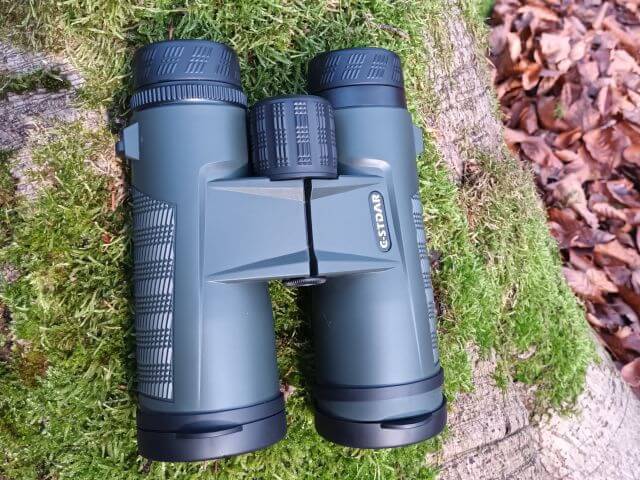
Using The C-STDAR 10×42 Waterproof Binoculars
The binoculars are great for general use, nature and wildlife observation, birdwatching, hunting even at sea thanks to their waterproofness.
It can cope with rough handling, the rubberized outside offers good grip and adequate protection.
The 10x magnification is fun and enables detailed observation. And with a lens of 42 mm, fully multi-coated lenses, and BAK 4 glass prisms, it offers bright and high-contrast images even in poor light.
To put it in a nutshell: “Really good binoculars for the money.”
Are C-STDAR Binoculars worth it?
The manufacturer made these waterproof binoculars for kayaking, hiking, bird watching, hunting, and outdoor adventure for those who need binoculars that work well without needing to fork out 1000 dollars.
The optical industry from the Far East is so modern and progressive that it is only a matter of time before the glass manufacturers in Kunming or Guangdong catch up with the world’s best optical glass manufacturers from Europe. The C-STDAR 10×42 Waterproof Binoculars are the best proof. It is incredibly affordable and has excellent features and good optical performance.
I think these binoculars will become very popular with outdoor enthusiasts and even have the potential to push aside some other bestsellers from their leading position.
I would buy this binocular model again and can certainly recommend it. The C-Stdar 10×42 Waterproof Roof Prism Binoculars are a bargain considering the workmanship and the above-average optical performance for such a wallet-friendly purchase price.
Are all models like the one I got? Quality controls need staff and that costs money. The more random samples are taken and checked for quality and accuracy, the more expensive the product becomes. You have to critically examine the model you have delivered. If something is faulty you can send it back for a replacement. The manufacturer has factored that in and provides a warranty on manufacturing or material defects.

